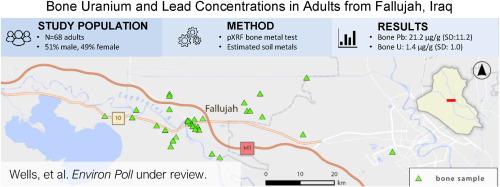Bone uranium and lead concentrations in adults from Fallujah, Iraq
IF 7.3
2区 环境科学与生态学
Q1 ENVIRONMENTAL SCIENCES
引用次数: 0
Abstract
Military activities may result in substantial exposure to heavy metals. Fallujah, Iraq has been the site of decades of war, and Iraq was one of the last nations to eliminate lead from gasoline. Therefore, the goal for this analysis was to assess bone lead and uranium concentration in Fallujah adults. To the best of our knowledge, this is the first time in vivo bone uranium has been reported. A portable X-ray fluorescence (XRF) device was used to measure bone lead and uranium in 68 adults (36 families). Generalized estimating equations determined associations with demographic characteristics. Mean bone concentrations were 21.2 μg/g bone mineral (95 % confidence interval (CI) 18.5, 23.9) for lead and 1.4 μg/g bone mineral (95 % CI: 1.2, 1.7) for uranium. Bone lead and bone uranium were not significantly correlated. Younger participants had significantly higher bone lead and uranium; females had significantly higher bone uranium compared to males. Estimated soil lead and uranium were available for 22 participants. Soil metal concentrations were not correlated with bone metal concentrations. Average bone metal concentrations in this population were >300 % higher than reported from prior studies using in vivo (lead) or bone ash (uranium) bone metal concentrations from North American adults. There is no known biological function for lead or uranium in the human body. These results suggest Fallujah adults have experienced very high, long-term exposure to multiple heavy metals.


伊拉克费卢杰成人骨铀和铅浓度
军事活动可能导致大量接触重金属。伊拉克的费卢杰(Fallujah)经历了数十年的战争,伊拉克是最后一批取消汽油含铅的国家之一。因此,本分析的目的是评估费卢杰成年人的骨铅和铀浓度。据我们所知,这是首次报道体内骨铀。采用便携式x射线荧光(XRF)仪对68名成人(36个家庭)的骨铅和铀进行了测定。广义估计方程确定了与人口统计学特征的关联。铅的平均骨浓度为21.2 ug/g骨矿物质(95%置信区间(CI) 18.5, 23.9),铀的平均骨矿物质浓度为1.4 ug/g (95% CI: 1.2, 1.7)。骨铅与骨铀无显著相关。年轻参与者的骨铅和铀含量明显较高;女性的骨铀含量明显高于男性。估计土壤铅和铀可供22个参与者使用。土壤金属浓度与骨金属浓度无相关性。该人群的平均骨金属浓度比先前使用北美成年人体内(铅)或骨灰(铀)骨金属浓度的研究报告高出300%。目前还没有已知的铅或铀在人体内的生物学功能。这些结果表明,费卢杰的成年人长期大量接触多种重金属。
本文章由计算机程序翻译,如有差异,请以英文原文为准。
求助全文
约1分钟内获得全文
求助全文
来源期刊

Environmental Pollution
环境科学-环境科学
CiteScore
16.00
自引率
6.70%
发文量
2082
审稿时长
2.9 months
期刊介绍:
Environmental Pollution is an international peer-reviewed journal that publishes high-quality research papers and review articles covering all aspects of environmental pollution and its impacts on ecosystems and human health.
Subject areas include, but are not limited to:
• Sources and occurrences of pollutants that are clearly defined and measured in environmental compartments, food and food-related items, and human bodies;
• Interlinks between contaminant exposure and biological, ecological, and human health effects, including those of climate change;
• Contaminants of emerging concerns (including but not limited to antibiotic resistant microorganisms or genes, microplastics/nanoplastics, electronic wastes, light, and noise) and/or their biological, ecological, or human health effects;
• Laboratory and field studies on the remediation/mitigation of environmental pollution via new techniques and with clear links to biological, ecological, or human health effects;
• Modeling of pollution processes, patterns, or trends that is of clear environmental and/or human health interest;
• New techniques that measure and examine environmental occurrences, transport, behavior, and effects of pollutants within the environment or the laboratory, provided that they can be clearly used to address problems within regional or global environmental compartments.
 求助内容:
求助内容: 应助结果提醒方式:
应助结果提醒方式:


